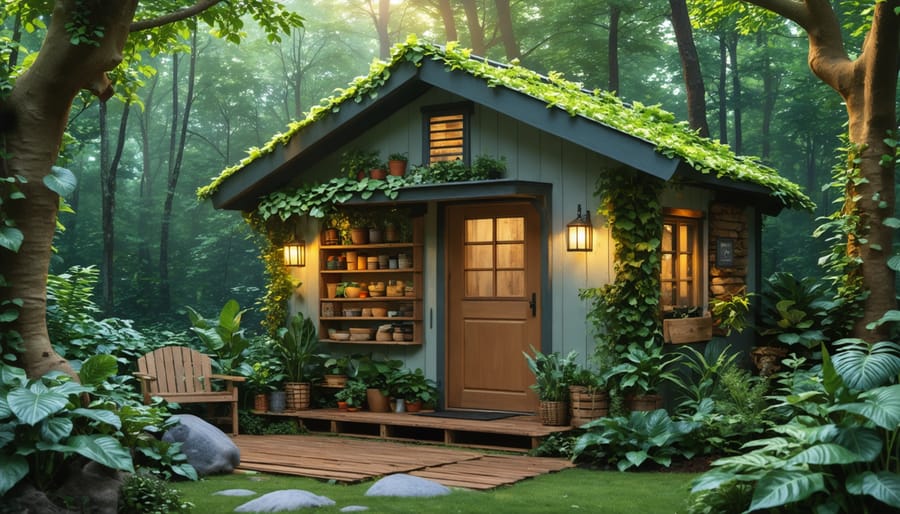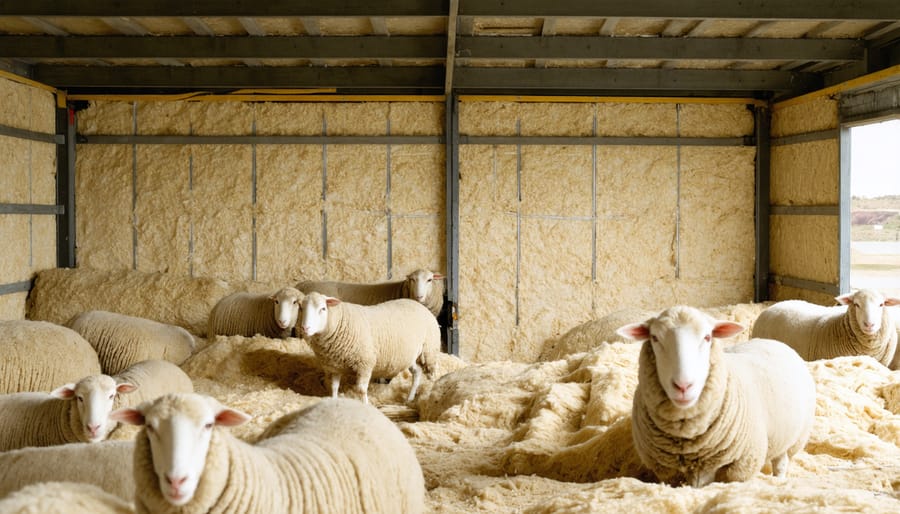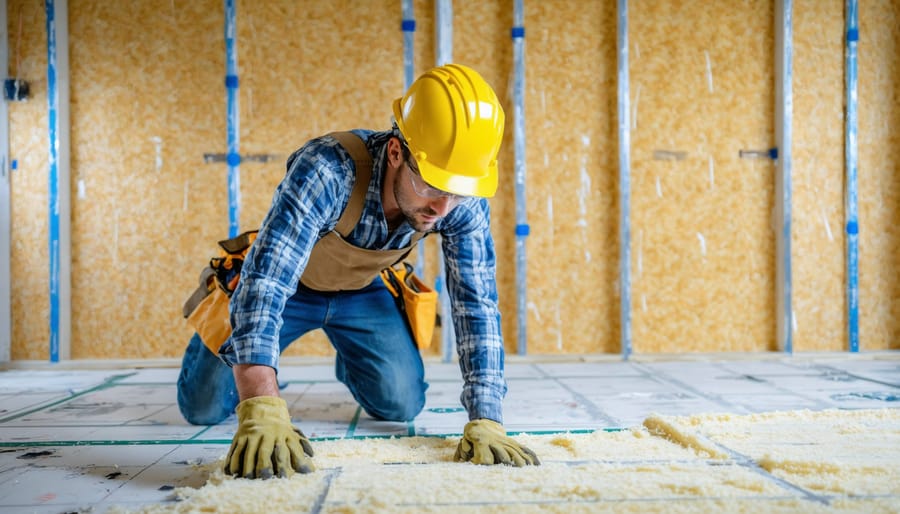Green Insulation That Keeps Your Shed Warm (And Your Bills Low)

Transform your shed into an energy-efficient sanctuary with natural insulation materials that protect both your storage and the planet. From recycled denim and sheep’s wool to innovative mushroom-based products, modern cost-effective insulation options offer superior thermal performance while minimizing environmental impact. These sustainable alternatives not only regulate temperature more effectively than traditional fiberglass but also reduce your carbon footprint and create healthier indoor air quality.
The growing demand for eco-friendly building materials has sparked a revolution in insulation technology, delivering solutions that are both highly effective and environmentally responsible. Whether you’re building a new shed or upgrading an existing structure, choosing green insulation materials represents a smart investment in both your property’s efficiency and our planet’s future. Recent studies show that natural insulation materials can reduce energy costs by up to 25% while lasting significantly longer than conventional options.
Natural Fiber Insulation Solutions
Sheep’s Wool: Nature’s Perfect Insulator
Sheep’s wool insulation stands out as one of nature’s most remarkable sustainable solutions for keeping your shed comfortable year-round. This natural material offers excellent temperature regulation, maintaining warmth in winter and coolness in summer, while being completely biodegradable at the end of its life cycle.
What makes wool particularly effective is its ability to absorb and release moisture without compromising its insulating properties. It can absorb up to 30% of its weight in water without feeling wet, helping to prevent condensation issues common in sheds. The natural crimped structure of wool fibers creates millions of tiny air pockets, providing superior thermal performance.
Installation is straightforward and safe, requiring no special protective gear. The wool comes in rolls or batts that can be easily cut to size and fitted between wall studs or ceiling joists. Unlike fiberglass, it won’t irritate your skin or airways during installation. As an added bonus, wool naturally resists pests and fire, and its natural lanolin content acts as a preservative, ensuring a long service life of 50+ years.
Best of all, choosing sheep’s wool supports sustainable farming practices while giving you a high-performance, eco-friendly insulation solution.

Cotton and Hemp Solutions
Cotton and hemp insulation materials offer an excellent eco-friendly alternative to traditional options, utilizing recycled and renewable resources. Recycled cotton insulation, made primarily from repurposed denim and other textile waste, provides impressive R-values while keeping textile waste out of landfills. This material is safe to handle, doesn’t irritate skin or airways, and contains no harmful chemicals.
Hemp insulation, derived from the strong fibers of industrial hemp plants, offers outstanding thermal performance and natural moisture regulation. It’s particularly effective at maintaining consistent temperatures in your shed while being naturally resistant to mold and pests. The material’s dense fiber structure also provides excellent sound dampening properties.
Both options are completely biodegradable at the end of their life cycle and require minimal energy to produce compared to synthetic materials. Installation is straightforward, as these materials can be cut to size with standard tools and fit snugly between wall studs. While they may cost more initially than traditional insulation, their durability and environmental benefits make them a worthwhile investment for eco-conscious shed owners.
Recycled Material Innovations
Recycled Denim Insulation
Transforming old denim into high-performance insulation is a brilliant example of sustainable innovation in the construction industry. Used jeans are collected, cleaned, and shredded into fibers that are then treated and processed into soft, fluffy insulation batts. This recycled material provides excellent thermal and acoustic properties, comparable to traditional fiberglass insulation, while keeping textile waste out of landfills.
One of the major advantages of denim insulation is its safety profile. Unlike fiberglass, it doesn’t contain harmful chemicals or irritants, making it safer to handle during installation. It’s naturally fire-resistant and doesn’t require additional chemical treatments. Each pack of denim insulation typically contains about six to eight recycled pairs of jeans, giving new life to clothing that would otherwise go to waste.
Many homeowners appreciate that denim insulation is mold-resistant and doesn’t absorb moisture easily. It’s also exceptionally durable, maintaining its shape and insulating properties for many years. While it may cost slightly more than traditional options, the environmental benefits and improved indoor air quality make it a worthwhile investment for eco-conscious shed owners.

Cellulose: From Paper to Protection
Transforming yesterday’s newspapers into today’s insulation, cellulose is a remarkable example of sustainable building materials. Made from up to 85% recycled paper products, this eco-friendly insulation option gives new life to materials that might otherwise end up in landfills. The paper is treated with non-toxic borate compounds, making it fire-resistant and pest-repellent while maintaining its earth-friendly qualities.
What makes cellulose particularly effective is its ability to fill gaps and conform to irregular spaces, creating a tight thermal barrier that reduces energy loss. When properly installed, cellulose achieves an impressive R-value of 3.5 per inch, making it competitive with traditional insulation materials. It’s especially good at reducing sound transmission, adding an extra layer of peace and quiet to your space.
Installation can be done through either the dry or wet-spray method, though the dry installation is more common for shed projects. The material can be easily blown into walls and ceiling cavities, making it an excellent choice for both new construction and retrofitting existing structures.
Installation Tips and Techniques
Preparation and Safety
Before installing eco-friendly insulation, proper preparation and safety measures are essential for both your well-being and the project’s success. Start by thoroughly cleaning your shed, removing any debris, and checking for signs of damage or rot. Pay special attention to moisture protection, as dampness can compromise insulation effectiveness and lead to mold growth.
Essential safety equipment includes:
– Protective gloves
– Safety goggles
– Dust mask or respirator
– Long-sleeved clothing
– Sturdy work boots
Ensure proper ventilation during installation by opening windows and doors. If working with loose-fill materials like wool or cellulose, wear a properly fitted dust mask to avoid inhaling particles. When handling recycled materials, inspect them carefully for any sharp edges or foreign objects.
Before beginning, measure your shed’s dimensions accurately and add 10% extra for waste. Check local building codes regarding insulation requirements and fire safety standards. Clear the workspace around your shed and set up proper lighting if working in darker conditions.
Store your eco-friendly insulation materials in a dry place until installation, and avoid working during wet weather. If you’re unsure about any aspect of the installation process, consider consulting a professional to ensure proper application and maximum effectiveness of your sustainable insulation choice.

DIY Installation Steps
Before starting your DIY insulation project, gather all necessary tools including protective gear, utility knife, measuring tape, and a staple gun. Ensure your workspace is well-ventilated and clear of obstacles.
Begin by measuring the wall cavities between studs, ceiling joists, or floor joists where you’ll install the insulation. Cut your eco-friendly insulation material slightly larger than the measured dimensions to ensure a snug fit.
For batts or rolls of natural fiber insulation:
1. Gently press the insulation into the cavity, starting at the top
2. Avoid compressing the material, as this reduces its effectiveness
3. Secure with staples every 8-12 inches if needed
4. Work your way down, ensuring no gaps remain
When installing loose-fill insulation:
1. Create a barrier using chicken wire or mesh
2. Pour or blow the material into the designated spaces
3. Maintain even distribution throughout
4. Check depth regularly to ensure proper coverage
For rigid board installation:
1. Cut panels to fit between framing members
2. Apply adhesive if necessary
3. Secure with appropriate fasteners
4. Seal joints with eco-friendly tape
Remember to wear long sleeves, gloves, and a dust mask during installation. Pay special attention to areas around windows, doors, and any utility penetrations, ensuring all gaps are properly sealed for maximum efficiency.
Final tip: Take photos before enclosing walls to document where insulation and any utilities are located for future reference.
Maintenance and Long-term Benefits
Maintaining eco-friendly insulation is surprisingly straightforward and rewards you with long-term energy savings and lasting performance. Unlike traditional materials, natural insulation typically requires minimal upkeep while providing consistent thermal protection year after year.
To ensure your eco-friendly insulation continues performing optimally, conduct visual inspections twice yearly, particularly after severe weather events. Check for any signs of moisture, which is rare but possible if there’s a roof leak. Most natural materials like hemp, wool, or recycled cotton are naturally resistant to mold and mildew, but addressing any water issues promptly helps maintain their effectiveness.
The long-term benefits of eco-friendly insulation extend beyond energy efficiency. These materials often improve with age, settling into place and maintaining their insulating properties for 25-50 years or more. Many homeowners report improved air quality and more consistent temperatures throughout the seasons. Additionally, as energy costs continue to rise, your initial investment in sustainable insulation becomes increasingly valuable.
Remember to keep proper ventilation in your shed to maximize the insulation’s performance. This helps regulate moisture levels and ensures the natural properties of your eco-friendly insulation continue working effectively for years to come.
Choosing eco-friendly insulation for your shed is more than just a trend – it’s a conscious step toward a more sustainable future. By selecting natural or recycled materials, you’re not only creating a comfortable space but also reducing your environmental impact. These green alternatives offer excellent thermal performance while minimizing harmful chemicals and reducing waste in landfills.
The benefits extend beyond environmental considerations. Many eco-friendly options provide superior moisture control, better air quality, and longer-lasting performance compared to traditional materials. Plus, as energy costs continue to rise, the investment in sustainable insulation pays off through reduced heating and cooling expenses.
Remember, every sustainable choice we make contributes to a healthier planet. Whether you opt for sheep’s wool, recycled denim, or cellulose insulation, you’re making a positive impact. Consider these earth-friendly alternatives for your next insulation project – your shed, the environment, and future generations will thank you for it. Start your green journey today by choosing insulation materials that work in harmony with nature while meeting your practical needs.

